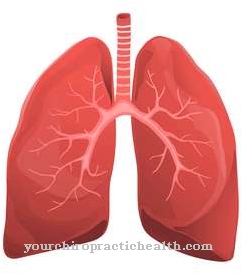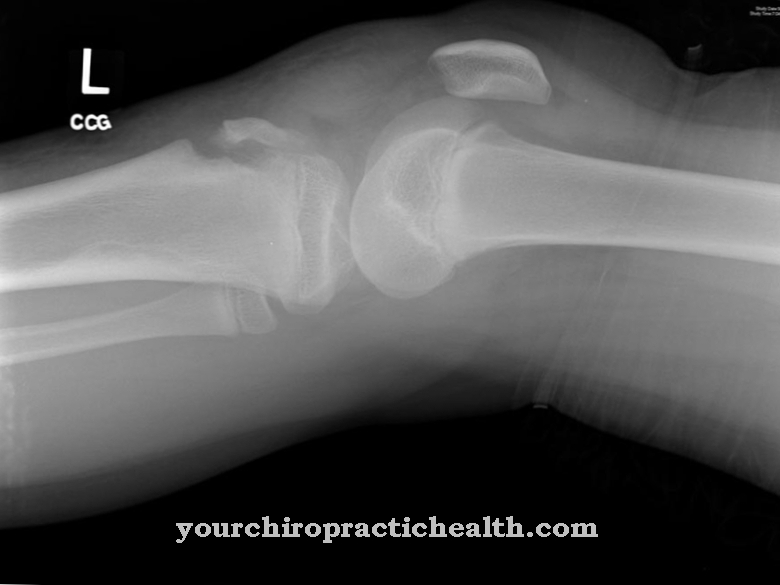Coxiella burnetii is a rod-shaped bacterium that can cause Q fever in humans. The protozoa lives as a parasite within cells and is often transmitted from animals to humans. It is also used as a biological weapon.
What is Coxiella burnetii?

© Kateryna_Kon - stock.adobe.com
Coxiella burnetii is a rod-shaped bacterium. The protozoan lives aerobically: it needs oxygen in order to be able to carry out metabolic processes. Coxiella burnetii is a relatively small bacterium at 0.4 µm. Biology does not assign it to the cocoid bacteria, which are spherical, but often describes it as "almost cocoid".
Coxiella burnetii causes Q fever (query fever) in humans. The pathogen belongs to the Coxiellaceae family. Originally, biologists assumed that Coxiella burnetii belonged to the Rickettsiaceae family.This group of bacteria includes many pathogens that, like Coxiella, live as parasites in a host and feed on it. However, modern genetics have shown that the genome of Coxiella burnetii is very different from that of the Rickettsiaceae. This means that they cannot belong to this family.
In the course of these investigations, researchers also found that Coxiella does not belong to the same class as the Rickettsiaceae. The bacterium provides a clear example of the importance of modern genetic studies for the systematics of living beings. In the case of pathogens, the correct classification is very important in practice: the better a bacterium is researched, the more effective treatments are possible.
Occurrence, Distribution & Properties
As a parasite, Coxiella burnetii needs a host in order to survive permanently. However, the bacteria can survive for a time without a host. Under these living conditions, its cell wall thickens, which forms a protective shield against the outside world. It is also responsible for the unicellular organism being more resistant than other bacteria. Drought can hardly harm him; even after several months without fluids, Coxiella remains active and infectious.
However, the thickened cell wall also has disadvantages for Coxiella burnetii: The additional cell mass must be constantly repaired and renewed in order to maintain protection. Maintenance not only consumes energy, but also building materials. In addition, a thicker cell wall makes it more difficult for nutrients to be transported into the cell. Even waste products that the bacterium excretes can only be disposed of with increased effort.
The cell wall therefore thins as soon as Coxiella burnetii is inside a host cell. Such a host can, for example, be a cell in a human body. The bacterium penetrates the membrane of the human cell and surrounds itself with a vacuole. A vacuole is a cavity within the cell that can move like a bubble within the host cell. A membrane delimits the vacuole from the outside. Inside the host cell, Coxiella burnetii influences the cell's metabolism and changes it in such a way that the cell no longer functions correctly. As a result, it triggers various symptoms.
Sheep are the main vectors of Coxiella burnetii. The bacterium reaches humans somewhat less often via goats or cattle. Dogs, cats, and other pets are also possible vectors. Ticks mostly help Coxiella burnetii to spread among animal hosts; In principle, it is possible that people can also be infected in this way.
Coxiella burnetii is highly infectious. Medicine regards the bacterium as one of the most contagious microorganisms of all. Scientists use the ID50 to measure how infectious a pathogen is. This is the dose that is necessary to infect 50% of the test animals with the disease. In Coxiella burnetii, the ID50 is 1. Only 1–10 bacteria are required to cause infection. Even a bacterium that penetrates the body can spread rapidly through cell division and infect a critical number of cells.
Symptoms, ailments & signs
The Coxielle burnetii pathogen can lead to goat flu or Q fever. This disease manifests itself through a number of clear symptoms. At first there are general symptoms such as fever, weakness and headache.
The body temperature continues to rise in the course of the disease and ultimately leads to serious circulatory problems. Many sufferers also complain of muscle or limb pain, which mainly occurs in the hands and thighs, depending on where the pathogen is located. The disease can also cause chills and severe malaise.
These complaints are accompanied by a general weakness. The mental and physical performance decreases massively and the person concerned can usually no longer participate in working life. The severe form of Q fever causes serious symptoms after just a few days. If the disease is not treated quickly, the pathogen can cause pneumonia or even hepatitis.
In less severe cases, the symptoms of the flu subside in about a week to ten days. Contagion with Coxiella burnetii cannot be seen externally. However, the symptoms evoke the typical signs of illness, i.e. pale skin, sweating and darkly discolored eye rims.
Complications
In most cases, Coxiella burnetii causes so-called Q fever. This fever can be very dangerous for humans and in the worst case it can also lead to death. As a rule, this leads to discomfort in the lungs, causing them to become inflamed. The liver can also be damaged by inflammation.
The affected person suffers from the usual symptoms of fever and flu. He feels weak and has pain in his extremities and muscles. Chills and a general feeling of illness also occur. The affected person has no appetite and thus loses weight.
The symptoms in the lungs usually lead to a cough, which may be connected with blood. The immune system is extremely weakened by the disease and can even lead to pericarditis. It is not uncommon for women who have the disease to miscarry.
Although the fever is relatively contagious, it can be treated well so that there are no further complications after treatment. Treatment is causal and symptomatic, but has to start early. If left untreated, the disease is usually fatal for the patient.
When should you go to the doctor?
If high fever, muscle pain, and other characteristic symptoms of Coxiella burnetii are noted, a doctor should be consulted. Detected early on, the chances of recovery from Q fever are relatively good. At the latest, when signs of liver, heart or brain inflammation appear, we recommend going to the nearest hospital. The same applies to coughing up blood or cardiovascular problems. Affected women should speak to the gynecologist. Pregnant women have an increased risk of miscarriage - so it is essential to see a doctor and have the fever cleared up.
It is also best to see a doctor for complaints that increase rapidly and do not go away after the usual time. Medical clarification and treatment is necessary solely because of the risk of infection. If left untreated, Coxiella burnetii is usually fatal. If there are serious complications, this must be examined by a doctor and treated if necessary. In addition to the family doctor, depending on the symptoms, a cardiologist or a specialist in internal medicine can also be visited. If the symptoms worsen quickly, the emergency medical service should be contacted.
Doctors & therapists in your area
Outlook & forecast
The Coxiella burnetii has an individual prognosis. If the Q fever breaks out, healing can occur within a few weeks. Symptoms are flu-like and are treated with medication. As soon as the patient takes sufficient care of himself and follows the instructions of the doctor, freedom from symptoms can be achieved after 2-3 weeks. In these cases, consequences are not to be expected.
Without medical care, however, in the worst case, death of the person concerned is a possible course. In the worst case, the Coxiella burnetii can damage the organs. Inflammation of the lungs or liver is possible. Depending on the severity of the inflammation, the age of the patient and any previous illnesses, the course of the disease can be unfavorable.
With a weakened immune system, the healing process is greatly delayed or the body is unable to heal the inflammation. In addition to breathing disorders and the development of an anxiety disorder, functional failures of the organs are possible. These represent a potential danger to life for the patient.
With an early diagnosis and the quick start of treatment, a favorable prognosis can be expected. However, if the person concerned also suffers from psychological impairment, recovery is difficult. A return of Coxiella burnetii is possible at any time with the same prognosis.
Illnesses & ailments
Coxiella burnetii causes the so-called Q fever (query fever) in humans and animals. The Australian pathologist Edward Holbrook Derrick described the reportable disease for the first time in 1937. He called the fever "query" (German: "questionable"), because the bacterial cause was still unknown at the time. Derrick encountered Q fever when several workers in a slaughterhouse contracted the previously unknown fever. There is a high probability that they were infected from infected animal bodies.
From a global perspective, Coxiella burnetii can be found almost all over the world. The only exceptions are New Zealand and Antarctica. However, Q fever tends to manifest itself in different ways. Doctors in North America often diagnose pneumonia first. In contrast, in Europe the disease is often noticeable as liver inflammation.
In humans, Coxiella burnetii usually causes only mild symptoms. Around half of those infected have flu-like symptoms such as fever, muscle pain and headache, feeling weak, chills, cough and loss of appetite. Gastrointestinal symptoms are less common, but they may also occur.
The infection often leads to inflammation of the lungs and / or liver. Inflammation is an immune system response designed to fight the invader. Q fever is highly contagious, but is usually not fatal. However, long-term consequences are possible, which in extreme cases u. a. can lead to miscarriages and malformations. In chronic Q fever, Coxiella burnetii causes pericarditis. Chronic Q fever is often fatal if untreated.
Aftercare
With Coxiella burnetii, the person affected usually has only a few measures or options for aftercare available. This disease requires comprehensive treatment of the disease so that it does not lead to further complications or further worsening of the symptoms. The earlier the disease Coxiella burnetii is detected, the better the further course is usually.
The disease itself can be treated relatively well with the help of medication. There are no particular complications. The affected person should rest and take care of his body, strict bed rest is to be observed. When taking the medicinal product, it should also be noted that a doctor should always be consulted first if there are any questions or if anything is unclear.
Since Coxiella burnetii can also have a negative effect on the patient's breathing, smoking should be avoided completely. The loving care and support from your own family or friends also have a positive effect on the course of this disease. As a rule, the life expectancy of the person affected by Coxiella burnetii does not decrease if the disease is detected early.
You can do that yourself
To avoid further complications or disturbances, the patient should temporarily stay away from animals. Until it has been clarified how the pathogens could get into the organism, protective measures are advisable. In particular, it must be prevented that other bacteria or germs can infect the patient.
Since the disease can be fatal without medical care, a doctor's visit is advisable. The instructions of the medical professionals must be followed so that a life-threatening condition does not arise. You are not allowed to take medication on your own responsibility. This is especially true for pain relievers. Due to the numerous risks and side effects, the risk of complications is significantly increased.
Various measures must be taken to stabilize mental strength. A generally positive attitude towards life is helpful in coping with the complaints. In addition, the organism can be supported by a balanced and healthy diet. This enables the body's own immune system to mobilize sufficient defenses to reduce the number of pathogens.
Sick people should ensure good sleep hygiene. Sufficient and above all restful sleep is important. The air should be supplied with sufficient oxygen. Pollutants such as alcohol, nicotine or drugs are to be avoided as a matter of principle. They deprive the organism of important forces in coping with the disease.






.jpg)





.jpg)



.jpg)










.jpg)
